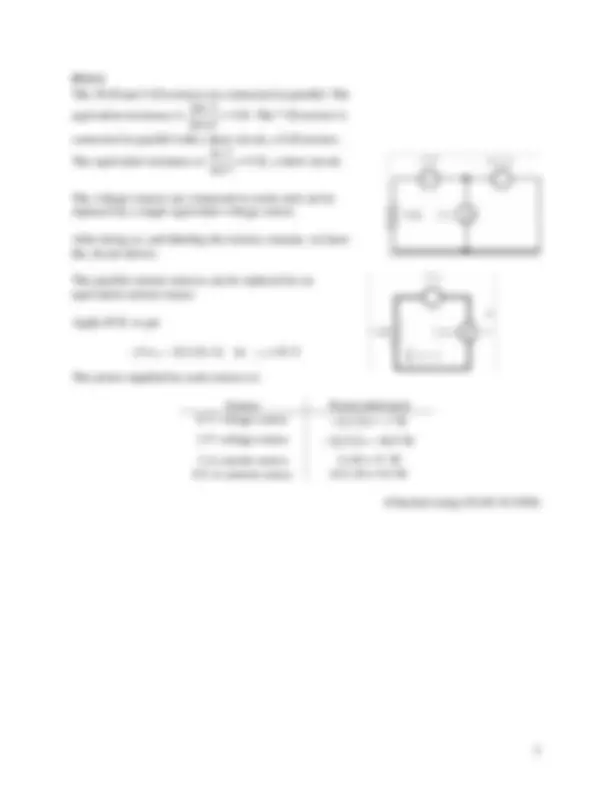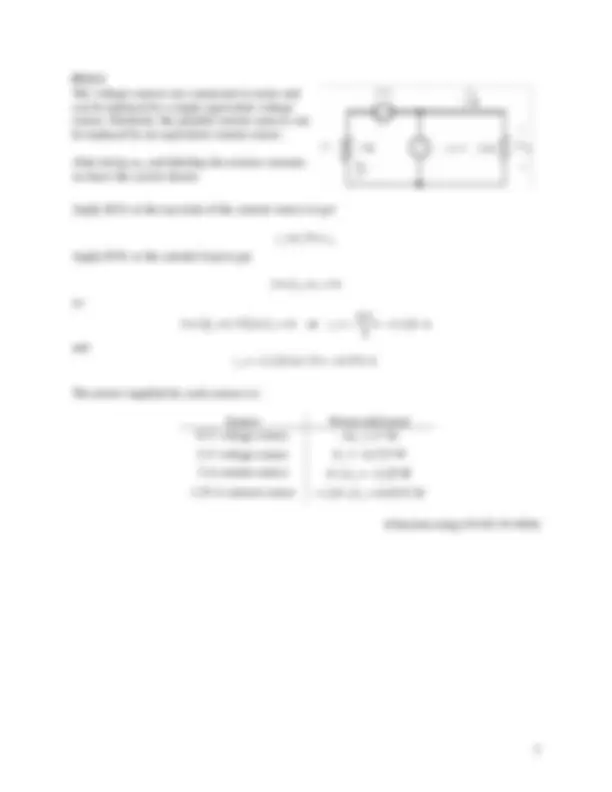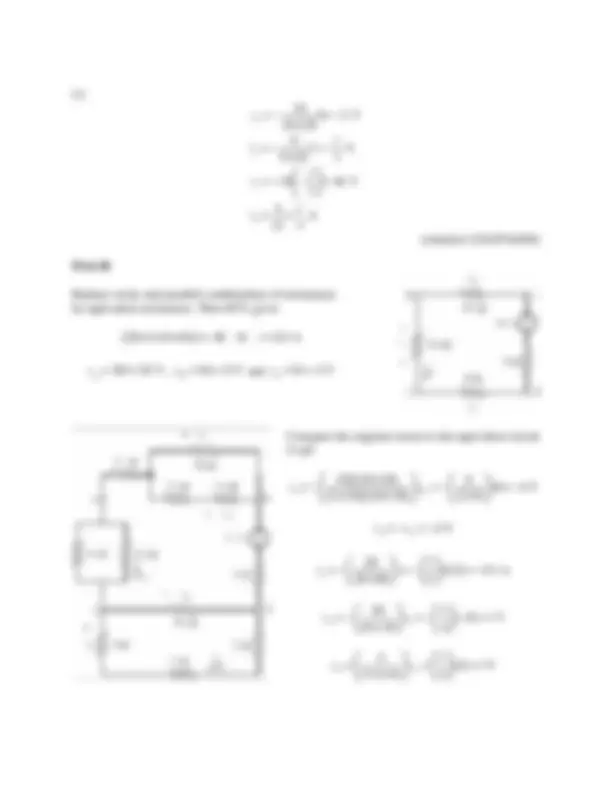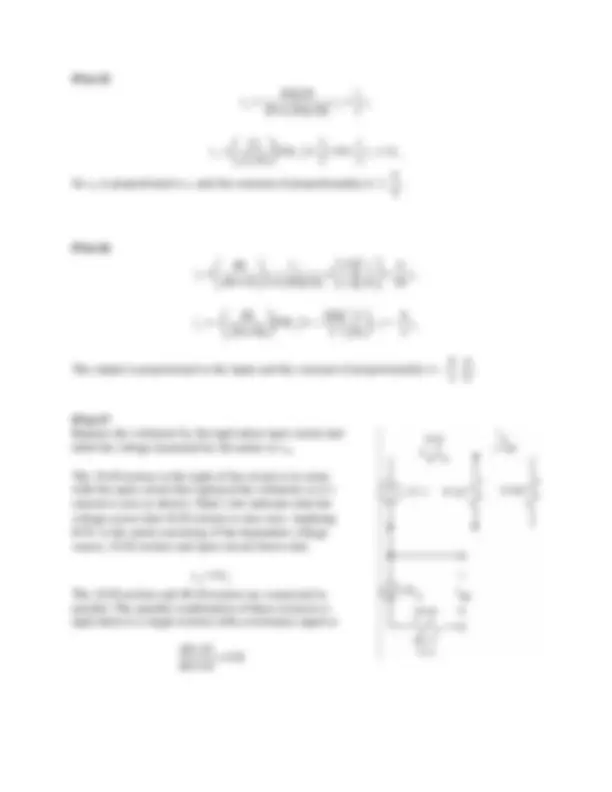












































Estude fácil! Tem muito documento disponível na Docsity

Ganhe pontos ajudando outros esrudantes ou compre um plano Premium


Prepare-se para as provas
Estude fácil! Tem muito documento disponível na Docsity
Prepare-se para as provas com trabalhos de outros alunos como você, aqui na Docsity
Os melhores documentos à venda: Trabalhos de alunos formados
Prepare-se com as videoaulas e exercícios resolvidos criados a partir da grade da sua Universidade
Responda perguntas de provas passadas e avalie sua preparação.

Ganhe pontos para baixar
Ganhe pontos ajudando outros esrudantes ou compre um plano Premium
Comunidade
Peça ajuda à comunidade e tire suas dúvidas relacionadas ao estudo
Descubra as melhores universidades em seu país de acordo com os usuários da Docsity
Guias grátis
Baixe gratuitamente nossos guias de estudo, métodos para diminuir a ansiedade, dicas de TCC preparadas pelos professores da Docsity
Resolução em ingles do cap 3 de Introdução aos circuitos elétricos - Dorf.
Tipologia: Exercícios
1 / 50

Esta página não é visível na pré-visualização
Não perca as partes importantes!











































Section 3-2 Kirchhoff’s Laws
Apply KCL at node a to get 2 + 1 = i + 4 ⇒ i = -1 A
The current and voltage of element B adhere to the passive convention so (12)(-1) = -12 W is
power received by element B. The power supplied by element B is 12 W.
Apply KVL to the loop consisting of elements D , F , E , and C to get
4 + v + (-5) – 12 = 0 ⇒ v = 13 V
The current and voltage of element F do not adhere to the passive convention so (13)(1) = 13 W
is the power supplied by element F.
Check: The sum of the power supplied by all branches is
Apply KCL at node a to get 2 = i 2 + 6 = 0 ⇒ i 2 = −4 A
Apply KCL at node b to get 3 = i 4 + 6 ⇒ i 4 = -3 A
Apply KVL to the loop consisting of elements A and B to get
Apply KVL to the loop consisting of elements C , D , and A to get
Apply KVL to the loop consisting of elements E , F and D to get
4 – v 6 + (-2) = 0 ⇒ v 6 = 2 V
Check: The sum of the power supplied by all branches is
2
2 2
1
1 1
KVL : 12 (3) 0 (outside loop)
12 3 or 3
KCL 3 0 (top node)
3 or 3
R v
v v R R
i R
i R R i
(a) (^12) 3 3( ) 21 V
v
i
(b)
2 1
(checked using LNAP 8/16/02)
(c)
1
2
24 12 , because 12 and adhere to the passive convention.
2 A and 2. 3 2
9 3 , because 3 and do not adhere to the passive convention
3 V and 3 3
i i
i R
v v
v R
The situations described in (b) and (c) cannot occur if R 1 and R 2 are required to be
nonnegative.
( )
3 3 P 2 V (^) 2 1 10 2 10 2 mW
− − = + ⎡^ × × ⎤= × = ⎣ ⎦
( )
3 3 P 3 V (^) 3 2 10 6 10 6 mW
− − = + ⎡^ × − × ⎤= − × = − ⎣ ⎦
(checked using LNAP 8/16/02)
R R
R R
R
R
i i
v v
v R i
(checked using LNAP 8/16/02)
R R
R R
R
R
v v
i i
v R i
(checked using LNAP 8/16/02)
KCL at node b :
KCL at node a :
1 1
1
( )
2 2
2
(checked using LNAP 8/16/02)
The subscripts suggest a numbering of the sources. Apply KVL to get
v (^) 1 = v (^) 2 + v (^) 5 + v (^) 9 − v 6
1
i and do not adhere to the passive convention, so 1
v
p (^) 1 = i v 1 1 (^) = i (^) 1 ( v (^) 2 + v (^) 5 + v (^) 9 − v 6 )
is the power supplied by source 1. Next, apply KCL to get
i (^) 2 = − (^) ( i 1 + i 4 )
i (^) 2 and v 2 do not adhere to the passive convention, so
p (^) 7 = − i v 7 (^) 7 = − i (^) 7 ( − v (^) 6 )= i 7 v 6
is the power supplied by source 7. Next, apply KCL to get
i 8 (^) = − i 4
i 8 and v 8 do not adhere to the passive convention, so
p (^) 8 = i v 8 8 (^) = (^) ( − i 4 (^) ) v (^) 8 = − i v (^48)
3
is the power supplied by source 8. Finally, apply KCL to get
i (^) 9 = i 1 + i
i (^) 9 and adhere to the passive convention, so v 9
p (^) 9 = − i v 9 (^) 9 = − (^) ( i 1 (^) + i 3 ) v 9
is the power supplied by source 9.
(Check: .)
9
1
n^0 n
p
=
∑ =
The subscripts suggest a numbering of the circuit elements. Apply KCL to get
i (^) 2 + 0.2 + 0.3 = 0 ⇒ i 2 = −0.5 A
The power received by the 6 Ω resistor is
( )
2 2 p (^) 2 = 6 i 2 = 6 −0.5 =1.5 W
Next, apply KCL to get
i (^) 5 = 0.2 + 0.3 + 0.5 =1.0 A
The power received by the 8 Ω resistor is
( )
2 2 p (^) 5 = 8 i 5 = 8 1 = 8 W
Next, apply KVL to get
v (^) 7 =15 V
The power received by the 20 Ω resistor is
(^2 ) 7 7
v p = = =
is the power supplied by source 7. Finally, apply KCL to get
9
i = 0.2 + 0.5 =0.7 A
The power received by the 5 Ω resistor is
( )
2 2 9 9
p = 5 i = 5 0.7 = 2.45W
We can label the circuit as follows:
The subscripts suggest a numbering of the circuit elements. Apply KCL at node b to get
i (^) 4 + 0.25 + 0.75 = 0 ⇒ i 4 = −1.0 A
Next, apply KCL at node d to get
i (^) 3 = i 4 + 0.25 = −1.0 + 0.25 = −0.75 A
Next, apply KVL to the loop consisting of the voltage source and the 60 Ω resistor to get
v (^) 2 − 15 = 0 ⇒ v 2 =15 V
v 1 (^) = 10 i 1 = (^10) ( −1.5 (^) ) = −15 V , v (^) 5 = 10 i 5 = 10 1( ) = 10 V and v (^) 8 = 10 i 8 = (^10) ( −0.5 (^) ) = −5 V
Apply KVL to the loop consisting of the voltage sources and the 25 Ω resistor to get
− 5 + 15 + v (^) 4 = 0 ⇒ v 4 = −10 V
Apply Ohm’s law to the 25 Ω resistor to get
4 4
v i
Apply KCL at node a to get
i 1 (^) + i (^) 2 = i (^) 4 ⇒ i (^) 2 = i (^) 4 − i 1 = − 0.4 − −( 1.5) =1.1 A
Apply KCL at node e to get
i (^) 6 + i (^) 8 = i (^) 4 ⇒ i (^) 6 = i (^) 4 − i 8 = − 0.4 − −( 0.5) =0.1 A
Apply KVL to the loop consisting of the 1.5 A current source, the 5 V voltage source and two 10
Ω resistors to get
v 1 (^) + v (^) 3 − v (^) 5 + 5 = 0 ⇒ v (^) 3 = − 5 + v (^) 5 − v 1 = − 5 + 10 − − ( 15 ) =20 V
Finally, apply KVL to the loop consisting of the 0.5 A current source, the 15 V voltage source
and two 10 Ω resistors to get
v (^) 7 + v (^) 8 − 15 + v (^) 5 = 0 ⇒ v (^) 7 = 15 − (^) ( v 5 (^) + v 8 ) = 15 − (^) ( 10 + −( 5 ))=10 V
(Checked: LNAPDC 8/28/04)
We can label the circuit as shown.
The subscripts suggest a numbering of the
circuit elements. Apply KVL to node the left
mesh to get
1 1 1
i + i − = ⇒ i = =
Apply KVL to node the left mesh to get
v (^) 2 − 25 i 1 (^) = 0 ⇒ v (^) 2 = 25 i 1 = 25 0.5( )=12.5 V
Apply KCL to get i (^) m= i 2. Finally, apply Ohm’s law to the 50 Ω resistor to get
2 m 2
v i = i = = =
(Checked: LNAPDC 9/1/04)
We can label the circuit as shown.
The subscripts suggest a numbering of the
circuit elements. Ohm’s law to the 8 Ω resistor
to get
1 1 8
v i =
Apply KCL at the top node of the CCCS to get
1 1 1 2 2 1 1 1
v i + v = i ⇒ i = i + v = + v = 1
v
Ohm’s law to the 12 Ω resistor to get
v (^) 2 = 12 i (^) 2 = 12 0.375 ( v 1 )= 4.5 v 1
Apply KVL to the outside loop to get
1 2 1 1 1
v + v − = ⇒ v + v = ⇒ v = =
Apply KCL to get i (^) m= i 2. Finally,
i (^) m = i (^) 2 = 0.375 v 1 = 0.375 3.636 ( ) =1.634 A
(Checked: LNAPDC 9/1/04)
2 1 1 (^1 ) 1 1 1
v + i + v = ⇒ i − + i + i = ⇒ i = =
Finally,
v (^) m = 80 i 1 = 80 0.09375 ( ) =7.5 V
(Checked: LNAPDC 9/1/04)
i = = and
v = =
1
= = Ω and (^2)
(Checked: LNAPDC 9/28/04)
Apply KCL at node a to
determine the current in the
horizontal resistor as shown.
Apply KVL to the loop
consisting of the voltages source
and the two resistors to get
-4(2-i) + 4( i ) - 24 = 0 ⇒ i = 4 A
18 0 12 0 30 V and 3 9 A 5
− + − − v a = ⇒ va = − im = va + ⇒ im =
10 4 8 0 6 V and 4 24 V 3
− v a − + va − = ⇒ va = = vm = va =
Section 3-3 Series Resistors and Voltage Division
v
v v
v
(checked using LNAP 8/16/02)
( )
(28 V and do not adhere
to the passive convention.)
a R
b i R
c p i
i
(checked using LNAP 8/16/02)
( )
( )( )
a.) 18 12 V 120 240
b.) 18 0.9 W 120 240
c.) 18 2 18 2 2 120 15 120
d.) 0.2 0.2 120 0.8 30 120
(checked using LNAP 8/16/02)
All of the elements are connected in series.
Replace the series voltage sources with a single equivalent voltage having voltage
Replace the series 15 Ω, 5 Ω and 20 Ω resistors by a single equivalent resistance of
By voltage division
v
(checked: LNAP 6/9/04)
Use voltage division to get
a^ (^ )
v
Then
i (^) a = 0.2 20 ( ) =4 A
The power supplied by the dependent source is given by
p = ( 120 ) i a=480 W
(checked: LNAP 6/21/04)
(a) Use voltage division to get
( )
p m s (^1) p p
aR v v a R R
av s
therefore
s m 360
v
So the input is proportional to the input.
(b) When v s = 24 V then (^) m
. When then v m = 3 V. When v m = 10 V then
o θ = 45
o θ = 150
(checked: LNAP 6/12/04)
Replace the (ideal) voltmeter with the equivalent open
circuit. Label the voltage measured by the meter. Label
some other element voltages and currents.
Apply KVL the left mesh to get
a a a
8 i + 4 i − 24 = 0 ⇒ i =2 A
Use voltage division to get
Section 3-4 Parallel Resistors and Current Division
i
i
i
i
( )
( )
( )
a R R
b v
c p
1 1
2 2 2
or
8 (2 ) 2 or 2
i R R i
R i i R R i
( )
( )
1
2
a i R
b i R
( ) (^1 2 1 )
1 2 1 2 1 1 1 2 1 2
will cause i= 2 1 A. The current in both and will be 1 A. 2
c R R R R
( )
( )
Current division:
i
i
i i i
current division: and 2 1 2
Ohm's Law: yields 2 2
plugging in 4 , > 9 V gives 3.15 A 1
and 6 , 13 V gives 1
i i R R s
v i R o
v R R o i s (^) R R
R v i o s
R v i o s
So any 3.15 A i 3.47 A keeps 9 V v 13 V. s o